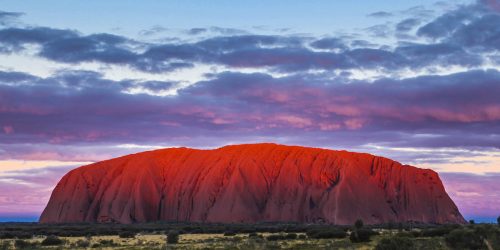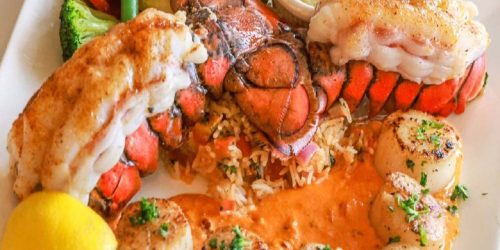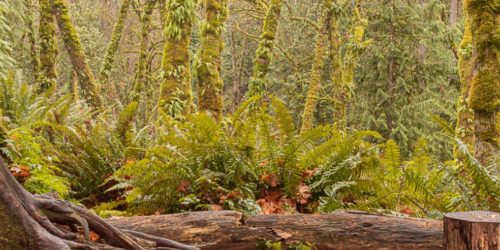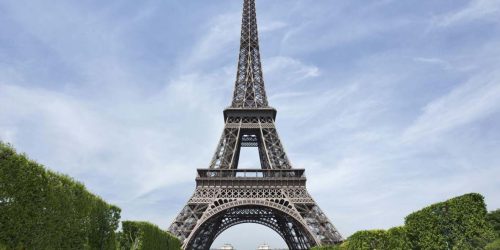The Migration of the Red Crabs on Christmas Island, Australia: A Spectacular Natural Phenomenon
I am constantly drawn to the wonders of nature, and the migration of the red crabs on Christmas Island in Australia is undoubtedly one of the most awe-inspiring spectacles I have ever witnessed. This natural event is not only a hallmark of Christmas Island but also a breathtaking annual occurrence that attracts tourists from all over the world. With great anticipation, I embarked on a journey to Christmas Island to personally experience the grandeur and beauty of this red tide.
The Phenomenon of the Christmas Island Red Crab Migration
Christmas Island, a remote Australian territory located in the Indian Ocean, is a small yet biologically rich island situated approximately 1,550 kilometers northwest of the Australian mainland and around 350 kilometers south of Java, Indonesia. Despite covering an area of just 135 square kilometers, Christmas Island has earned global recognition for one of nature’s most extraordinary events: the annual mass migration of the red crabs. This remarkable spectacle is a true testament to the wonders of the natural world and showcases the island’s unique biodiversity.
A Natural Wonder: The Migration of the Red Crabs
Every year, typically between the months of November and December, the island undergoes a dramatic transformation as tens of millions of red crabs embark on a synchronized mass migration from the dense inland rainforests to the coastline. This extraordinary journey is primarily driven by the crabs’ need to breed, and it is one of the most significant natural migrations on Earth. The migration begins following the first significant rainfall of the wet season, which usually coincides with the lunar cycle and favorable tidal conditions. This ensures that the timing of the migration is perfectly synchronized with the best conditions for the crabs’ reproductive success.
The red crabs, known scientifically as Gecarcoidea natalis, are land-dwelling creatures that spend most of their lives hidden within the island’s dense rainforests. They are typically solitary animals, but the breeding season triggers a profound behavioral change. During this time, millions of red crabs emerge simultaneously from their burrows and begin a treacherous journey towards the coastline. Their singular goal is to reach the shore, where they will mate and lay their eggs. This migration is not just an incredible visual spectacle but also a crucial event for the survival of the species.
The Journey to the Coast: A Test of Endurance and Survival
The migration of the red crabs is entirely governed by natural rhythms and instinct. As the crabs leave their forest homes, they move en masse, covering vast distances across challenging terrain. The island becomes a sea of red as the crabs march across roads, fields, and even through human settlements. They navigate steep cliffs, cross busy roads, and face various natural and man-made obstacles along the way. The sight of millions of crabs scuttling across the landscape, determinedly heading towards the ocean, is both mesmerizing and humbling.
One of the most astonishing aspects of this migration is the crabs’ ability to navigate. Despite having no centralized direction, the crabs seem to instinctively know the correct route to the ocean. As they travel, they follow paths that have been used for generations, guided by environmental cues and an innate sense of direction. However, their journey is fraught with danger. The crabs must contend with predators such as the yellow crazy ant, an invasive species that has caused significant harm to the red crab population in recent years. Additionally, the crabs face the risk of being crushed by vehicles as they cross roads. To mitigate these risks, the Christmas Island government has implemented various measures to protect the migrating crabs. Roads are temporarily closed during peak migration periods, and specially designed crab bridges and tunnels have been constructed to help them cross safely.
The Final Destination: Reaching the Shoreline
After days of arduous travel, the crabs finally reach the island’s beaches. For many, this marks the culmination of a long and perilous journey. Once they arrive, the crabs engage in mating rituals on the sandy shores. The males typically arrive first and dig burrows in which mating takes place. After mating, the males return to the forest, while the females remain near the shoreline to incubate their eggs.
The female crabs then wait for the optimal moment to release their eggs into the ocean, a process that is closely tied to the lunar cycle. The eggs are released during the receding high tide, just before dawn, when the water is calm and the conditions are ideal for the eggs to hatch. Each female can lay up to 100,000 eggs, which are carried in a brood pouch on the underside of her body. When the time is right, the females descend to the water’s edge and release the eggs into the ocean, where they hatch into larvae almost immediately. The larvae spend the first few weeks of their lives in the ocean before returning to the land as tiny juvenile crabs.
A Delicate Balance: The Role of Conservation Efforts
The red crab migration is not without its challenges. Despite the significant efforts made to protect the crabs, many still fall victim to natural predators, human activity, and environmental changes. The introduction of the yellow crazy ant to Christmas Island has had a devastating impact on the red crab population. These ants spray formic acid, which can kill the crabs and decimate entire colonies. In response, the Christmas Island National Park has launched extensive programs to control the ant population and protect the crabs during their migration.
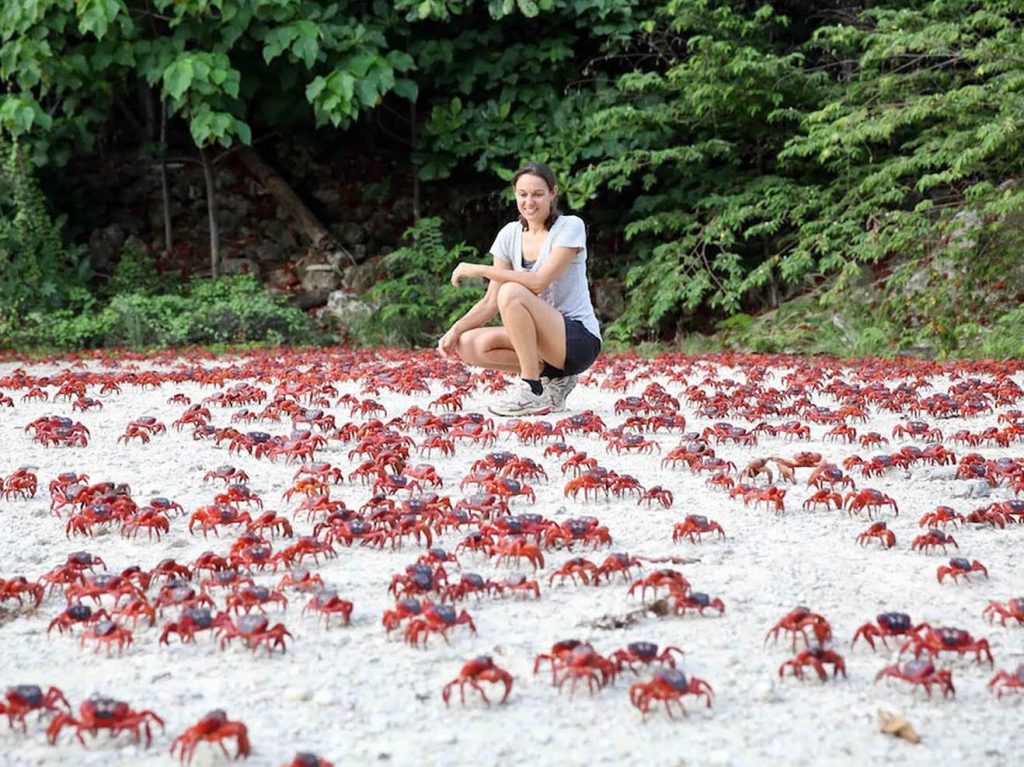
Furthermore, the island’s infrastructure has been adapted to accommodate the migration. The installation of crab bridges and tunnels, as well as the closure of certain roads during peak migration times, has significantly reduced the number of crabs killed by vehicles. These conservation efforts highlight the delicate balance between human activity and the preservation of natural phenomena.
A Once-in-a-Lifetime Experience
For those fortunate enough to witness it, the migration of the red crabs on Christmas Island is a once-in-a-lifetime experience. It is a reminder of the incredible power and beauty of nature, as well as the importance of conservation. The island’s stunning landscapes, coupled with the sheer scale of the migration, create an unforgettable spectacle that leaves a lasting impression on all who visit.
Whether you are a nature enthusiast, a photographer, or simply someone who appreciates the wonders of the natural world, the red crab migration is an event that should be on your travel bucket list. The sight of millions of crabs moving in unison, driven by a primal instinct to reproduce, is a powerful and humbling experience that connects us to the rhythms of the natural world.
How to Get to Christmas Island?
Although Christmas Island is a relatively remote destination, it has become more accessible in recent years due to the increasing global interest in the red crab migration. Here are the main ways to reach Christmas Island:
- By Air:
The most convenient way to reach Christmas Island from mainland Australia is by air. Currently, there are direct flights from Perth and Singapore to Christmas Island. Perth serves as the primary gateway, with a flight to Christmas Island taking approximately three hours. The flight from Singapore takes about two hours. Christmas Island Airport (IATA: XCH) is the island’s only airport, and while it is small, it offers essential services for travelers. - Charter Flights:
For those seeking a more flexible and personalized experience, charter flights are available from Perth or Darwin to Christmas Island. Charter flights not only offer greater freedom in scheduling but also provide stunning aerial views of the Indian Ocean, adding a unique touch to the journey. - By Sea:
While there are no regular passenger ferry services to Christmas Island, some special cruises pass by the island each year. These cruises are usually tailored for nature enthusiasts and adventure travelers, with itineraries that include visits to Christmas Island and other remote islands in the region. If you have ample time and a passion for maritime travel, this could be a distinctive option.
The Unique Landscape and Hiking Experiences on Christmas Island
Beyond the red crab migration, Christmas Island is a paradise for nature lovers. The island boasts rich biodiversity and pristine natural landscapes, making every step an adventure filled with discovery. The red crab migration is not the island’s only attraction—here are some other must-see sites and activities on Christmas Island:

- Dolly Beach:
Dolly Beach is one of the island’s most popular beaches and is a key site for the red crabs’ egg-laying process. It is also a significant habitat for sea turtles. Visitors can often witness the red crabs busily digging burrows on the beach, preparing to lay their eggs. Dolly Beach is also an ideal spot for diving and snorkeling, with its crystal-clear waters and vibrant coral reefs teeming with tropical fish. - Hugh’s Dale Waterfall Trail:
For those who enjoy hiking, the Hugh’s Dale Waterfall Trail is a must-do. This trail winds through tropical rainforests and leads to a hidden waterfall. Along the way, you will encounter clusters of red crabs aswell as a variety of rare plants and animals. The waterfall at the end is a breathtaking sight, with water cascading from a great height, surrounded by lush rainforest, filling the air with the refreshing scent of nature. - The Grotto:
The Grotto is a mysterious sea cave located on the western coast of Christmas Island. Entering the cave, you are enveloped by a profound sense of tranquility, making it an ideal place for meditation and reflection. The natural rock walls and pools within the cave create an otherworldly atmosphere, as if you have stepped into a different realm.
My Travel Experience
During my few days on Christmas Island, I was deeply moved by the awe-inspiring spectacle of the red crab migration. Walking along the island’s roads and trails, I was constantly surrounded by swarms of crabs, all marching resolutely toward the sea. Particularly at dawn, when the first rays of sunlight touched the earth, the sight of the crimson waves shimmering in the light was truly unforgettable.
I especially recommend visiting during the early wet season, when the red crabs are most active. Although the weather may be a bit humid, this is precisely when the crabs begin their mass migration. Witnessing these small creatures overcoming countless obstacles to fulfill their instinctual drive for survival and reproduction is a humbling and awe-inspiring experience.
Christmas Island is a place far removed from the hustle and bustle of the world. Here, nature’s raw beauty is on full display, and the island is home to one of the most incredible natural phenomena on Earth. For any nature lover or traveler, witnessing the red crab migration is a once-in-a-lifetime experience. I am confident that anyone who sets foot on this land will be profoundly moved by its wonder and beauty.
